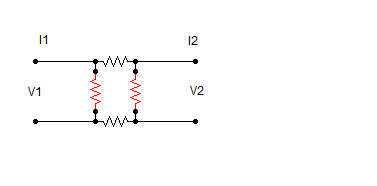To find the value of A, evaluate V1/V2 with the right-hand side of the circuit open (therefore I2 = 0).
To find the value of B, evaluate V1/I2 with the right-hand side of the circuit shorted (therefore V2 = 0).
To find the value of C, evaluate I1/V2 with the right-hand side of the circuit open (therefore I2 = 0).
To find the value of D, evaluate I1/I2 with the right-hand side of the circuit shorted (therefore V2 = 0).
If it helps, you can break the circuit into three smaller two-port networks: the left shunt admittance, the two middle series impedances, and the right shunt admittance. Find the ABCD matrix representation of each, and then simply multiply the three ABCD matrices in order from left to right (remember, matrix multiplication order matters). That's how I solved your problem. If you post what you think the correct answer is, maybe someone will tell you if you've gotten it right.
![[smile] [smile] [smile]](/data/assets/smilies/smile.gif)
By the way, I assumed both I1 and I2 go from left to right when I worked the problem, so I don't have the same sign convention in Figure 1 in the Wikipedia link. No big deal; it just means I don't need the negative signs when determining C and D.
xnuke
"Live and act within the limit of your knowledge and keep expanding it to the limit of your life." Ayn Rand,
Atlas Shrugged.
Please see FAQ731-376 for tips on how to make the best use of Eng-Tips.



![[smile] [smile] [smile]](/data/assets/smilies/smile.gif)
![[bigsmile] [bigsmile] [bigsmile]](/data/assets/smilies/bigsmile.gif)